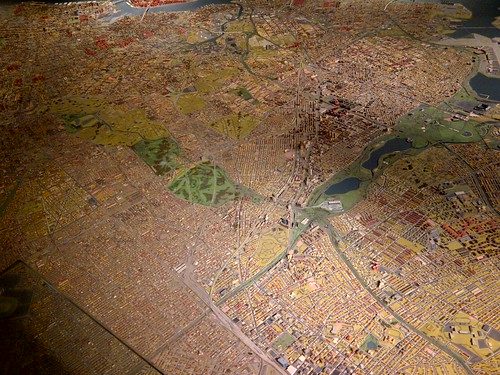rtb’s descriptions of the current exhibits at the Museum of the City of New York sounded right up my alley so off I went. I asked my friend Peter to come along, knowing that he would add alternate perspective to some of the exhibits.
After we met up in the lobby we stopped off for a map. The elderly UES docent asked if we’d been to the museum before and I said yes and started walking off but Peter said no and then was already for the volunteer’s history of the building and the museum. She mentioned the exhibit of the Sandy photos, which was sad even though it had happened to others (we did say we were from Queens – although I was not affected by the storm). Peter, having worked for the MTA for 30 years, had a lot to say about the graffiti exhibit even though we hadn’t even seen it yet. The docent and Peter talked about it for a while and then she asked him to write up his perspective and hand it back to her as we left.
We looked at Rising Waters first, which was photos and videos of Superstorm Sandy, its damage, and its aftermath. Over a year later it is still difficult to see.


City as Canvas I was very excited to see. The pieces are from the street art collection of Martin Wong. I remember looking out the front window of my HS in the early 70s and watching the elevated subway ride past. The colors, the markings – it was all so beautiful. I remember when there were just tags like Taki/183 and then the paintings by Lee, Futura 2000, and Lady Pink. Keith Haring’s radiant baby at every subway stop. The subway walls and the bridges with these painting that seemed to jump out at you as you rode by. But then the tagging got ridiculous and people started covering up other’s art and the city declared war and then most of it was gone.
For most of his time at the MTA, Peter’s job was to erase graffiti. So while I was looking at and getting lost in the art, he was in my ear talking about how Sane Smith’s work is still found in the system but on the video they were saying there were only a few pieces. And while Peter was seeing vandalism and vandals, I was seeing art and artists. What Peter was calling self-aggrandizement and just saying, “I was here,” I was calling voices of black and latinos and later gay men crying to be heard and telling the world, “Yes. I am here.” Needless to say the exhibit brought up a lot of feelings for Peter.


Activist New York started in the 1600s when Quakers fought for religious freedom and John Bowne and others fled to what is now Flushing House in Queens (you can still see the Quaker house in Queens and there’s John Bowne HS if anyone was wondering who the school was named after). The docent told us the exhibit went all the way to that scruffy sit-in at Wall Street (Occupy Wall Street). Even in the 1960s when I was in grade school there were obvious divisions between the Protestants and the Catholics – the anti-Catholic (mostly anti-Irish and anti-Italian) wounds of our grandparents still had not healed. Peter noted that to him the Henry Street Settlement was where heroin addicts went for help – his remembrances from the 60s and 70s. But the history of the Henry Street Settlement goes back to just before the turn of the 20th century. As the community’s needs changed, the Settlement met those needs.
Gilded New York is an exhibit of paintings, jewelry, clothing, and other objects of the NYC aristocracy of the late 19th and early 20th centuries. Peter said the wallpaper and ornaments looked like what he imagined a bordello looked like.
The part of the exhibit I liked was the fans – every Puerto Rican girl loves a fan.
Marine Paintings is just that. It was fun to Castle Clinton in Battery Park or Hell’s Gate through a late 19th century painter’s eyes.
An ongoing exhibit that we didn’t see was Timescapes, a 22-minute history of NYC. With luck it will be there the next time I visit the Museum of the City of New York.
By Carene Lydia Lopez





